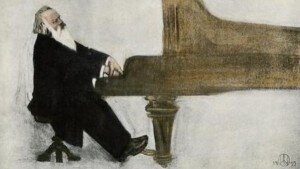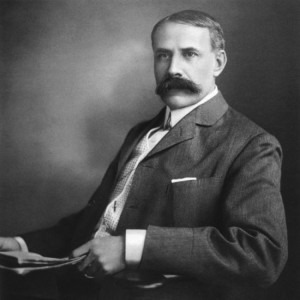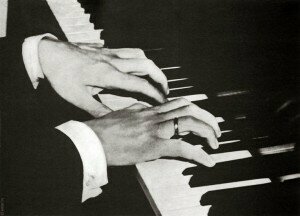Call me fickle, but as with food, I go through phases in terms of what I like to listen to and what I enjoy playing. However, I do have some favourites and they are mostly from the piano repertoire. Some are special because they are coloured by my personal ‘encounters’ with them, and others were chosen because the music speaks to me. Here goes:

Johannes Brahms at the piano
© Maryann Groves/North Wind Picture Archives
1. Brahms: Piano Concerto No. 1 in D minor, Op.15
I grew to love this concerto when a dear friend of mine was preparing for a performance and I acted as his ‘orchestra’ in rehearsals. It baffles me that out of the first five performances of the work, only one – the one in March 1859 with Hamburg Philharmonic – was well received. The audience even hissed at the second performance (in Leipzig)! In this concerto, Brahms sought to give equal footing to both soloist and orchestra in a symphonic scale, as opposed to giving the orchestra a purely accompanying role. He wrote technically difficult passages not for the sake of showing off the soloist’s skill, but as a structural vehicle for developing thematic material. I especially love the finale (Rondo) – it keeps me on my toes from start to finish!
Brahms: Piano Concerto No. 1 in D Minor, Op. 15 (Stephen Hough, piano; BBC Symphony Orchestra; Andrew Davis, cond.)
2. Schumann: Piano Concerto in A minor, Op.54
This concerto is extremely dear to me – it was one of the most enjoyable pieces that I have worked on with my teacher and mentor, Professor Sulamita Aronovsky. She suggested I learn this when I was given an opportunity to perform a concerto with a London orchestra, and I really felt ‘in my shoes’ playing it. Passionate yet sensitive, the music also reflects Schumann’s dual personalities: the dreamy Eusebius and the tempestuous Florestan. My favourite parts are the cadenza in the first movement (12:26) and the entire third movement (21:24), both of which are simply intoxicating!

Edward Elgar
Credit: https://www.cantonsymphony.org/
3. Elgar: Violin Concerto in B minor, Op.61
Many people are familiar with the Elgar Cello Concerto, but his Violin Concerto is not played as often. Lasting around 50 minutes, it is a mammoth work and is one of his longest orchestral compositions. Although Elgar was a violinist himself, he asked the leader of the London Symphony Orchestra in his time, W.H. Reed, for technical advice, who helped him with fingering and bowing; and the great violinist Fritz Kreisler, for whom the work was written, also made suggestions in order to make the solo part more playable! Though emotional in expression, I find the music very composed and quietly elegant, true to its Britishness!
Elgar: Violin Concerto in B Minor, Op. 61 (Hilary Hahn, violin; London Symphony Orchestra; Colin Davis, cond.)
4. Liszt: Hungarian Rhapsody No.6
This is my all-time feel-good piece of music – it is catchy, showy, humorous, and coquettish. It needs no more introduction – watch this video and be charmed!
5. Saint-Saëns: The Carnival of the Animals
This composition is a brilliant example of how music can imitate the world around us, and it is a great first piece of classical music to introduce to children. It has even been turned into a picture book with fanciful illustrations and a simple commentary so that children can listen to the included CD and follow each section of the piece!
6. Brahms: Piano Trio in B major, Op.8
I fell in love with this composition when I attended a chamber music camp during one of the school holidays. I was happily working on the Beethoven ‘Ghost’ Trio when I heard another ensemble play this piece in the practice room next door. As soon as I heard the lush opening melody, I literally felt all warm and fuzzy! The music that follows is deeply passionate, at times frenzied, sometimes sweet (especially the Trio melody in the second movement), and just overall intensely emotional. My idea of bliss would be lounging by the fireplace in a chalet, sipping a cup of hot chocolate, watching the snow fall gently, and listening to this sublime piece of music.

Rachmaninoff’s hands
7. Rachmaninoff: Rhapsody on a Theme of Paganini. Op.43
This is effectively the composer’s fifth piano concerto, as it is a set of variations for piano and orchestra, based on the last of Paganini’s 24 Caprices for solo violin. Rachmaninoff transforms this theme in many different ways, mostly remaining in the same key of A minor, except the middle seven variations, which explore a handful of different keys. The most well-known is the Eighteenth Variation (14:59), which features an inversion of the original melody in a most endearing manner. My favourite variation is the Fifteenth (10:54). Cheekily delightful like a child and intensely hot-blooded like young lovers, this variation ends with a magnificent flourish. Apparently Rachmaninoff himself found the final variation (21:49) so difficult technically that he doubted his own ability and had to calm himself down before each performance by drinking a glass of crème de menthe!
8. Prokofiev: Piano Concerto No.3 in C major, Op.26
Ever since I watched Martha Argerich’s performance of this concerto at the Royal Festival Hall in London, I have been listening to this work regularly because it brings me an overwhelming sense of exhilaration each time. I remember the soloist’s vibrant energy radiating across the Hall that evening, yet the audience was so still that one could hear a pin drop. If I never get to go to any more concerts this lifetime, I will still be satisfied because I attended this performance!
9. Chopin: Ballade No.4
As a pianist, how could I not include a work by Chopin? Of all the works he wrote, the Ballades, as a genre, are my favourites. They all have a wistful character that I find most touching. In particular, I am especially fond of the Fourth Ballade. This piece opens with a peaceful introduction set in the dominant major, akin to the calm before a storm, before leading us into a beautifully melancholic melody that undergoes various transformations, some rather turbulent. The music continues to waver between sweeter passages and dramatic outbursts until a tempestuous coda wraps up the work.

Portrait of Paul Schoenfield By Justin Pearson
© flickr
10. Paul Schoenfield: Café Music (for violin, cello, and piano)
This is my most recent discovery compared to the other pieces on my list. Schoenfield is an American composer who seasons his classical compositions with elements of jazz, folk, and popular music. He wrote Café Music after sitting in one night for the pianist at Murray’s Steakhouse in Minnesota. In his own words, he wanted to ‘write a kind of high-class dinner music – music which could be played at a restaurant, but might also find its way into a concert hall. The work draws on many of the types of music played by the trio at Murray’s.’ The second movement of this work (5:33) features a beautiful theme derived from a Hassidic melody.


